9256 AN EXTREMELY RARE PAIR OF GEORGE III LACQUER AND TÔLE PEINTE CENTER TABLES Pontypool. Last Quarter Of The 18th Century. Measurements: Height: 26″ (66cm) Width of Top Straight Across: 27 1/2″ (70cm) Maximum Width of Top on the Diagonal: 32″ (81cm)
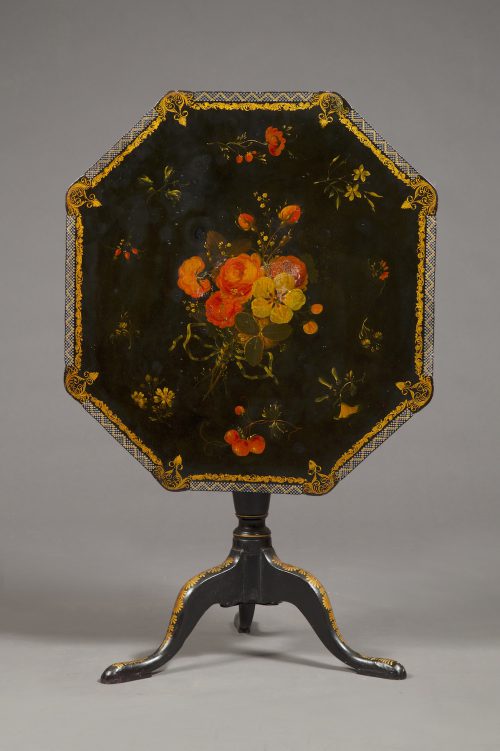
Research
Of tôle peinte and lacquer. Each with an octagonal painted tôle tilt-top with pierced edge, the center decorated with a floral spray, the top raised on a lacquered baluster stem and three cabriole legs with pad feet, the legs and feet with floral decoration. Minor differences in interpretation of each wooden base but both of a very similar date. Old touch ins to one top.
This rare pair of tables is a striking example of Pontypool lacquered tôle, one the eighteenth century’s most innovative decorative techniques. A closely comparable table in the collection at Colonial Williamsburg, dated to 1765 and with a rectangular top (figure 1), shares the same hand-punched pierced edging and eared corners of the present pair and is decorated with fruit and flowers in a style and composition closely related to that of these pieces. In addition, both the present pair and the Williamsburg table are raised on a lacquered baluster stem with three cabriole legs with pad feet.1
Pontypool lacquered tôle, named after its place of manufacture in south Wales, was famed for its exceptionally high luster. First developed by the ‘projecting genius’ Thomas Algood in the 1690’s, the technique involved the application of a linseed based oil to which could be added various pigments followed by high and precise firing. The results were very durable and bore exceptionally lustrous decoration in a variety of brilliant colors, exemplified in the decoration of present tables.2
Algood (d. 1716), was a Quaker who had fled religious persecution in Northamptonshire. He settled in the more tolerant Pontypool and took full advantage of the combination of local tin production and other minerals needed in the process to create his unique variety of lacquer. Algood’s son Edward and grandson Thomas further fostered the superior levels of technical expertise developed by the craftsmen who used Algood’s original technique and oversaw the production of objects of the highest quality as the century progressed.
By 1732 Pontypool objects were of such a quality that the diplomat Sir Charles Hanbury-Williams praised the new technique as ‘beautiful,’ and a large group of Pontypool japanned ware now in the Hermitage Collection is thought to have been a gift from him to Catherine the Great. As the eighteenth century progressed japanned tin was enthusiastically adopted in fashionable society, even threatening the craft of the traditional lacquer master.3
The majority of Pontypool’s output was of smaller objects such as vases and trays and, as such, the present tables, together with the Williamsburg example, represent the pinnacle of the firm’s production, bearing lacquered tôle tops of a significant size incorporated into fashionable furniture.
It is interesting to note that Pontypool items were on occasion incorporated as precious materials into pieces made by other workshops. One such example is an oval tea table by Georg Haupt, circa 1780, in the Swedish Royal Collection which features a tôle tray top with floral decoration (figure 2). The table was ordered by Gustav III and an inventory from 1809 makes it possible to trace the table to the Old Haga palace, where it was accompanied by a porcelain tea set from the French and Berlin manufactories.
Regarding the decorative themes, artists drew directly on the works of the great flower painters of the period. It is recorded that, during the approximate time of the production of the present tables, an artist named Benjamin Barker was employed at Pontypool to paint trays in the manner of the Dutch painter Jan van Huysum (1682-1749).4 Huysum was one of the most celebrated artists of the eighteenth century, counting the Kings of Poland and Prussia, Prince William of Hesse, the Duke of Orleans and Sir Robert Walpole among his patrons.5
Footnotes:
1. H. Huth, Lacquer of the West, London, University of Chicago Press, 1971, p. 111.
2. ibid., p. 112
3. ibid., 1971, plate 314.
4. ibid., 1971, p. 113.
5. P. Mitchell, European Flower Painters, London, Adam and Charles Black, 1973, p. 142.
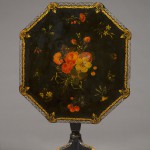

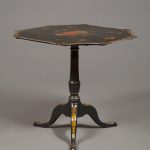
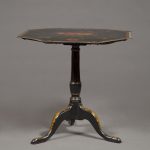
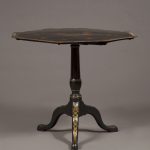

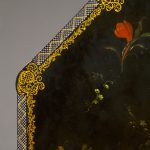
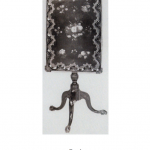
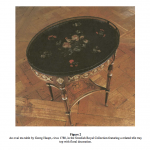
Comments are closed.